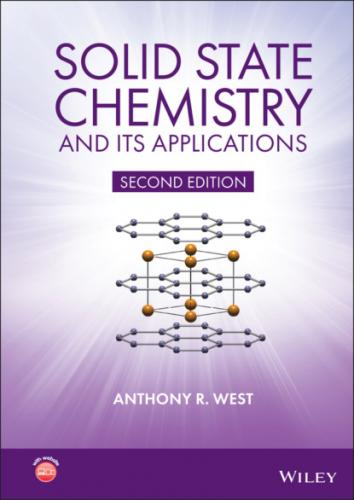A selection of compounds with wurtzite and NiAs structures is given in Table 1.12 and Table 1.13 with values of their hexagonal cell parameters a and c. The wurtzite structure is formed mainly by chalcogenides of divalent metals and is a fairly ionic structure. The NiAs structure is more metallic and is adopted by a variety of intermetallic compounds and some transition metal chalcogenides (S, Se, and Te). The value of the ratio c/a is approximately constant in the wurtzite structures but varies considerably in compounds with the NiAs structure. This is associated with the presence of metallic bonding which arises from metal–metal interactions in the c direction, as follows. First consider the environment of Ni and As:
Each As is surrounded by (Table 1.11):6 Ni in a trigonal prism at distance 0.707a12 As, hcp arrangement, at distance a.Table 1.13 Some compounds with the NiAs structureCompounda/Åc/Åc/aCompounda/Åc/Åc/aNiS3.43925.34841.555CoS3.3675.1601.533NiAs3.6025.0091.391CoSe3.62945.30061.460NiSb3.945.141.305CoTe3.8865.3601.379NiSe3.66135.35621.463CoSb3.8665.1881.342NiSn4.0485.1231.266CrSe3.6846.0191.634NiTe3.9575.3541.353CrTe3.9816.2111.560FeS3.4385.8801.710CrSb4.1085.4401.324FeSe3.6375.9581.638MnTe4.14296.70311.618FeTe3.8005.6511.487MnAs3.7105.6911.534FeSb4.065.131.264MnSb4.1205.7841.404δ′‐NbNa2.9685.5491.870MnBi4.306.121.423PtBa3.3584.0581.208PtSb4.1305.4721.325PtSn4.1035.4281.323PtBi4.3155.4901.272a Anti‐NiAs structure.R. W. G. Wyckoff, Crystal Structures, Vols 1 to 6, Wiley (1971).Figure 1.36 The primitive cubic unit cell of CsCl.
Each Ni is surrounded by:6 As, octahedrally, at distance 0.707a2 Ni, linearly, parallel to c, at distance 0.816a (i.e. c/2)6 Ni, hexagonally, in ab plane at distance a.
The main effect of changing the value of the c/a ratio is to alter the Ni–Ni distance parallel to c. Thus, in FeTe, c/a = 1.49, and the Fe–Fe distance is reduced to 0.745a [i.e.
1.17.4 Caesium chloride (CsCl)
The unit cell of CsCl is shown in Fig. 1.36. It is a primitive cube, containing Cl at corners and Cs at the body centre, or vice versa (note that it is not body centred cubic since there are different ions at corner and body centre positions). The coordination numbers of both Cs and Cl are eight with interatomic distances of 0.866a, Table 1.11. The CsCl structure is not cp. In a cp structure, each anion has 12 other anions as next nearest neighbours whereas in CsCl, each Cl has only six Cl– ions as next nearest neighbours (arranged octahedrally). Some compounds with the CsCl structure are given in Table 1.14. They fall into two groups, halides of large monovalent elements and a variety of intermetallic compounds.
Lanthanum hexaboride, LaB6, has the CsCl structure in which Cl is replaced by the octahedral cluster anion B6 3−. LaB6 has a low work function (i.e. it ionises easily) of 2.5 eV, very high electron emissivity, metallic conductivity and is stable in vacuum. These properties enable it to be used as a hot cathode in the electron gun in electron microscopes: advantages are that it has higher brightness and longer lifetime than traditional tungsten filament cathodes.
Although CsCl is not a cp structure, there is a link between it and the fluorite structure, which can be described as a primitive cubic array of anions with cations in alternate cube body centres, Fig. 1.34; in CsCl, all body centres are occupied.
Table 1.14 Some compounds with the CsCl structure
| Compound | a/Å | Compound | a/Å | Compound | a/Å | Compound | a/Å |
|---|---|---|---|---|---|---|---|
| CsCl | 4.123 | NH4Br | 4.0594 | CuPd | 2.988 | AlNi | 2.881 |
| CsBr | 4.286 | TlCl | 3.8340 | AuMg | 3.259 | LiHg | 3.287 |
| CsI | 4.5667 | TlBr | 3.97 | AuZn | 3.19 | MgSr | 3.900 |
| CsCN | 4.25 | TlI | 4.198 | AgZn | 3.156 | ||
| NH4Cl | 3.8756 | CuZn | 2.945 | LiAg | 3.168 |
1.17.5 Other AX structures
There are five main AX structure types, rock salt, CsCl, NiAs, sphalerite and wurtzite, each of which is found in a large number of compounds. There are also several less common AX structures. Some are distorted variants of one of the main structure types, e.g.:
1 FeO at low temperatures, <90 K, has a rock salt structure with a slight rhombohedral distortion (the α angle is increased from 90 to 90.07° by a slight compression along one threefold axis). This rhombohedral distortion is associated with magnetic ordering in FeO at low temperatures (see Chapter 9).
2 TlF has a rock salt‐related structure in which the fcc cell is distorted into a face centred orthorhombic cell by changing the lengths of all three cell axes by different amounts. The distortion arises because, in this structure, Tl+ (Xe core) 4f145d106s2 is a non-spherical cation exhibiting a stereochemically-active inert (or lone) pair effect.
3 NH4CN has a distorted CsCl structure (as in NH4Cl) in which the CN– ions do not assume spherical symmetry but are oriented parallel to face diagonals. This distorts the symmetry to tetragonal and effectively increases a relative to c.
Other AX compounds have completely different structures, e.g.:
1 Compounds of the d 8 ions, Pd and Pt (in PdO, PtS, etc.), often
